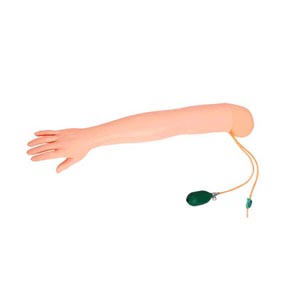11-03-2025
ADA MED SUPPLY LIMITED
Pediatric arterial injection is a highly challenging procedure, especially in emergency Settings, where medical personnel often need to complete the puncture procedure in a very short time to respond to a child's emergency condition. Because children have thin arteries, improper operation may lead to serious complications, such as vascular damage, bleeding and so on. Therefore, whether the children's arterial injection model can effectively simulate the high-pressure situation in the emergency environment has become a key factor to improve the technical level and emergency response ability of medical staff.

Child Arterial injection model
Challenges in first aid environments
In emergency Settings, children are often more difficult to locate blood vessels because of illness or accidents. For example, in pathologic states such as severe dehydration, low blood pressure or shock, children's blood vessels have weakened elasticity and are difficult to touch or locate. Medical personnel not only need to quickly determine the specific location of the blood vessels, but also need to accurately inject in a very short time, which requires high accuracy of operation.
Industry expert views : Simulating high-pressure situations in emergency environments is critical to improving the emergency response and technical capabilities of medical staff, experts say. Traditional training equipment usually simulates standard static situations and cannot reflect the sudden stress and complex clinical situations during emergency treatment. The child arterial injection model can simulate a variety of complex clinical changes, such as dynamic changes in blood flow and violent fluctuations in children's physiological state, so that medical staff can perform more accurately and calmly under pressure.
Techniques for simulating high-pressure situations
Child arterial injection model: can simulate multiple stress factors in emergency environment. Specifically, these devices help healthcare workers operate in highly stressful situations through real-time feedback, dynamic changes, and multi-context Settings. For example, when a medical practitioner performs a puncture, the device simulates the real-time responses of blood vessels, such as fluctuations in blood flow, pressure changes, and even complications such as airway obstruction.
In addition, some devices can also simulate a variety of interfering factors in the first aid environment, such as family members' emotional interference, equipment failure, etc. This diversified setting enables medical staff to practice how to adjust operational strategies and make timely judgments and reactions under real pressure.
Data Support : One study showed that healthcare workers using a pediatric arterial injection model were approximately 30% more likely to successfully complete the injection procedure in a simulated emergency setting than traditional training methods. In addition, the reaction time and accuracy of the trainers in high-pressure situations were also significantly improved. Real-time feedback and dynamic adjustments enable healthcare professionals to quickly adapt to changing clinical situations and reduce complications due to operational errors.
Clinical significance and application
Children's arterial injection model: Training equipment that simulates emergency situations provides valuable practical opportunities for medical staff to remain calm and make accurate decisions under pressure. This training not only improves the accuracy of the operation, but also helps the medical staff to better understand the clinical changes in the first aid, such as vasoconstriction, dramatic changes in the physiological state of the child, etc. By practicing in a simulated environment, medical staff can better cope with various difficulties that may be encountered in actual first aid and ensure the safety of children in first aid.
Conclusion
Pediatric arterial injection models, especially those that simulate high-pressure situations in emergency Settings, significantly improve the emergency response and operational accuracy of medical personnel. Through high simulation and real-time feedback, these devices help medical staff stay calm under pressure and accurately complete injection operations, reducing complications caused by improper operations in the clinic. In the face of changing and complex clinical situations, the training model simulating the emergency environment undoubtedly provides effective support for the medical staff, ensuring the safety and timeliness of the treatment of pediatric patients.